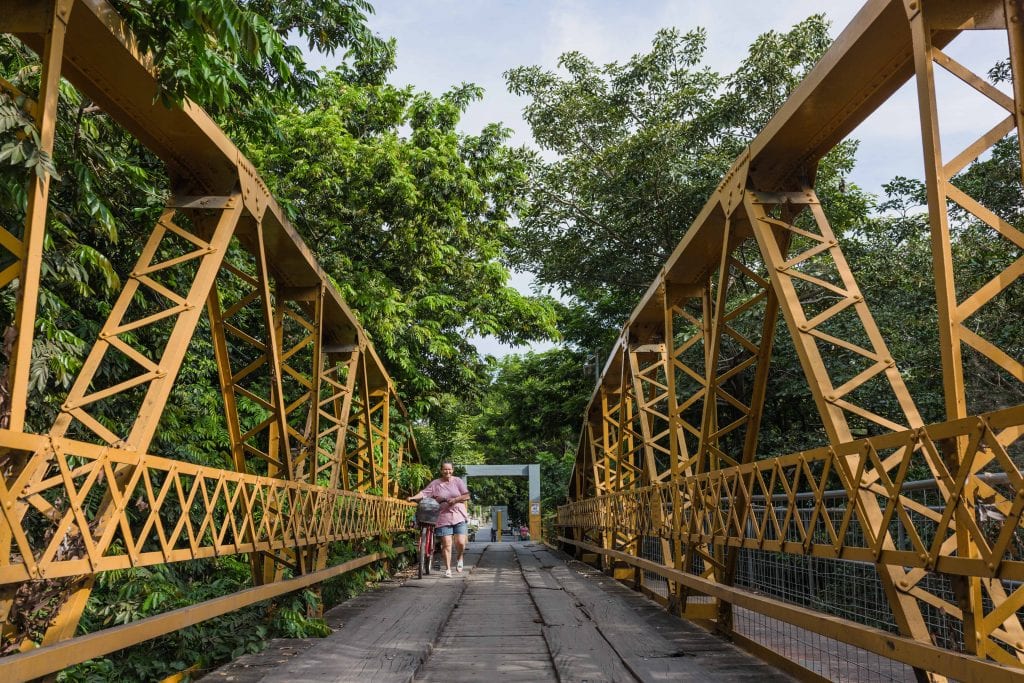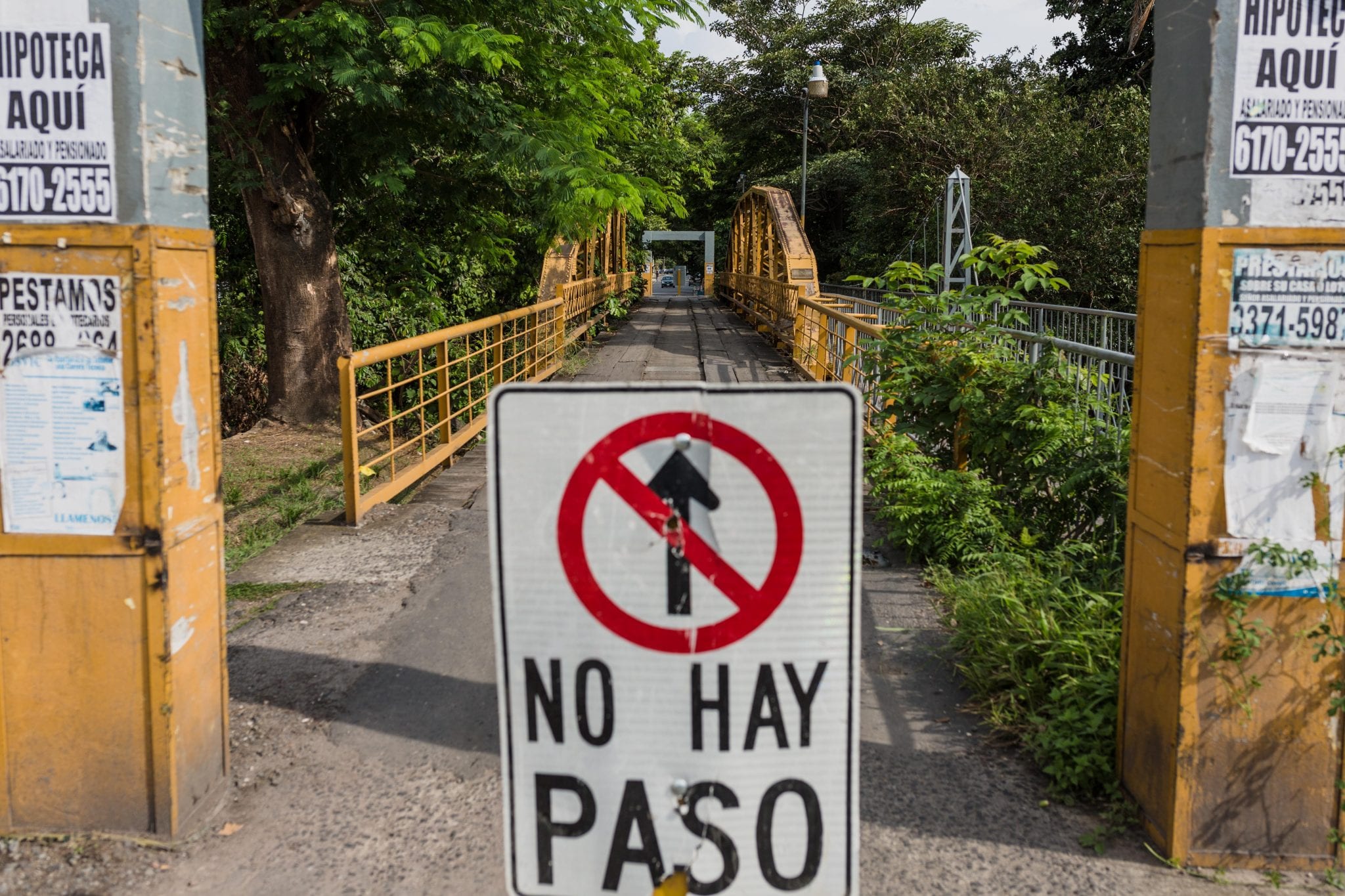
The Municipality of Liberia will repair the disputed Puente Real bridge, but will not open it for vehicles or trucks to cross due to a study commissioned by this local government, which concluded that the infrastructure is so deteriorated that it could not support them even if it is reinforced.
This bridge connects the north with the south of the Liberian city, but the car crossing has been closed for more than two years. So dozens of people who live in the neighborhoods to the south have to take a longer route to travel by car from one community to another.
That situation will not change. The municipality decided to preserve the bridge’s structure and invest in repairing the pedestrian, bicycle and motorcycle crossing. Currently, the bridge provides this same service but the infrastructure and signage are not in optimal condition.
Now the municipality will have to invest almost ¢130 million (about $220,000) to repair it, a project that it hopes to carry out in 2021.
Both the administration and the Council are open to carrying it out this year. Rather, it is a priority to execute it,” said engineer Dorian Ulate, who is director of the Technical Unit Road Management for the Municipality of Liberia.
Historical Heritage
Why not repair the bridge to bear the weight of all types of vehicles crossing or build a new one? The municipality ran into two limitations to do so.
First, in 2011, the bridge was declared a historic-architectural heritage of Costa Rica, so it can’t be demolished to build a new one in its place.
Why did it receive this title? “Its construction was the transforming element of the city of Liberia. It is the most valuable bridge in Liberia due to its economic, cultural and political significance, due to being the main access to the city,” explained Carlos Manuel Zamora, Heritage Center historian, to The Voice of Guanacaste in 2018.
Carts, horseback riders and pedestrians had to go around the Liberia River to go from Liberia to Bagaces and Bebedero, so the bridge’s arrival meant support for those communities, but today it’s no longer very functional, concluded the study on its heritage declaration.
In addition, the bridge is one of the few from that time period that still exists in the country and, due to its materials, it represents a sample of the fast-paced progress in the construction of bridges, the text added.
Despite this, the previous municipal administration tried unsuccessfully to get this declaration removed.
The former mayor, Viales, attempted to annul the bridge’s heritage declaration to build a new bridge in its place.
To achieve this, they wanted to use a line of credit that they had available with the National Bank of Costa Rica (BNCR- Banco Nacional), explained municipal engineer Ulate.
Through legislators, they tried to draft a bill, which in the end didn’t get anywhere, to remove the declaration, but since it wasn’t accomplished, they decided to do the study,” added Ulate.
The idea of removing this declaration hasn’t been completely buried. Bill 21.761, presented last year by Congressman Rodolfo Peña to repeal the declaration and thus demolish the Puente Real and build a new two-lane bridge, is in the ordinary legislative waiting line.
However, the proposal hasn’t advanced in Congress since then and the municipality has other plans in mind.
What the Technical Study Found
The municipality commissioned Camacho y Mora S.A., a firm of engineers and consultants, to study the condition of the bridge for an approximate cost of ¢14 million (about $23,500).
The contract stipulated that the study had to consider two options: restoration or reinforcement.
The first option analyzed the possible repair and maintenance of the infrastructure to keep it open exclusively for pedestrians and motorcycles. The second studied a more profound change to open crossing to all vehicular traffic, including cars and trucks.
The conclusions reached by the study identify the municipality’s second limitation.
“Since the bridge’s capacity presents so much deficit to support the load that its reinforcement is not justified. In case enabling the route for this type of load is desired, the bridge should really be replaced,” Jose Pablo Camacho, an engineer from Camacho y Mora, explained to the municipal council on December 16, 2020. On the other hand, the first option is possible.
The bridge is in poor condition. All along the entire infrastructure, there is corrosion and loss of paint, the wooden boards are not in optimal condition, and the connectors between the wood and the beams don’t work, are out of place and deteriorated.
Before this analysis, there were criteria on the condition of the bridge but no technical basis to determine what to do, commented Ulate, the municipality’s road management director.
The firm Camacho y Mora also estimated how much the work will cost the municipality. It is about ¢125,398,000 (about $212,500), which includes materials (some parts must be replaced) and labor.
Ulate pointed out that the municipality is taking into account almost ¢130 million (about $220,000) for the project, of which they already have ¢30 million (about $51,000).
“The district councils have ¢30 million to execute projects and they made the decision to set it aside to allocate it to this project,” added Ulate.
To make up the shortfall, he explained, the municipality intends to take advantage of funds assigned to the municipality through some laws that can be destined to this bridge, for example, airport funds and different taxes.
Ulate will meet with the municipal council to discuss where the resources will come from. Once approved, the municipality has to open a new bidding process to contract the company that will develop the project.

Former mayor Julio Viales, from the National Integration Party, tried to annul the bridge’s national heritage declaration in order to build a new bridge in its place, considering that it was “useless,” but he was unsuccessful. Photo: Cesar Arroyo CastroPhoto: César Arroyo
Bridge Without Maintenance?
Former mayor Julio Viales closed the Puente Real crossing as of August 2018, but this has been a source of discord for a long time and its deterioration was evident.
“Physically its structure has a normal condition due to neglect, little maintenance and the behavior of its materials (wooden planks and cracks in the substructure),” stated the technical study for declaring the bridge as heritage, prepared in 2009 by the Center for Research and Conservation of Cultural Heritage (CICPC) from the Ministry of Culture and Youth.
In 2013, the Ministry of Culture restored the bridge with an investment of more than ¢90 million (about $180,000 at the time), but it has already reached its useful life.
They say that this bridge was restored a few years ago, that it was painted and everything, but when you look at it, it doesn’t seem that the work was the way it should be, because when you look at the structure, it’s eaten away,” engineer Carlos Fernandez, from the Camacho y Mora consulting firm, told the municipal council.
The bridge must be preserved because of its heritage status, but area residents would like to see at least one alternate crossing opened up.
This isn’t new either. Options that the municipality should analyze have been being discussed since before the heritage declaration.
When the Liberian Cultural Association requested the declaration, it presented a report prepared on August 29, 2005 by an official from the Ministry of Public Works and Transportation, which back then indicated that the bridge should be preserved and that “a new crossing at the level of 6th Street ” should be developed. This was noted in the CICPC document.
In the council session on December 16, 2020, one of the questions put on the table was whether it would be better to move the bridge to another place— where it would be exhibited as heritage— and build a new one where the current one is located.
In this regard, Fernandez, the engineer from the consulting firm, indicated that it isn’t an element that has been considered in the study because it isn’t within the scope of his job as consultant, but that, considering the cost of maintenance, the best long-term option would be to build a new bridge.
However, for now, the municipality isn’t evaluating this option, just its repair.
So what’s left to do? First, the municipality must present to the municipal council the details of how it will obtain the necessary funds for repairing the bridge and with the council’s approval, it must open a new bidding process to contract the project developer.
Additionally, as stipulated in the heritage decree, partial or total remodeling of the structure requires prior authorization from the CICPC.
In the meantime, it also remains to be seen if the bill to remove the bridge’s heritage status is revived or stays buried.




Comments